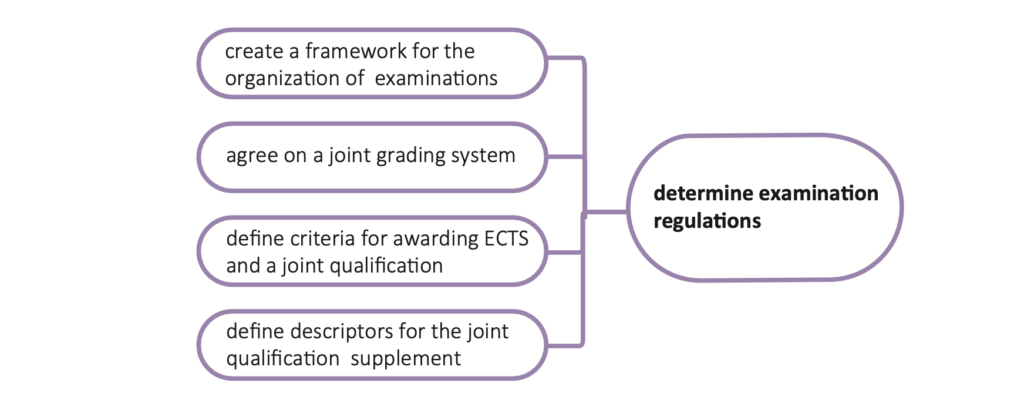
| The programme team develops joint examination regulations by which following aspects have to be considered: |
| Create a joint framework for the organization of the examinations; |
| Agree on a joint grading system; |
| Define criteria for awarding ECTS and a joint qualification; |
| Define descriptors for the qualification supplement. |
Guidelines
Create a joint framework for the organization of the examinations
Partners should agree on joint examination methods and mechanisms to assess learner performance, especially with regard to types of examinations, academic and professional recognition, identity verification and proctoring exams (TESLA, 2019).
Formative assessment and feedback, as well as peer evaluation, are tools to enhance learning during the course and promote effective learning.
Explicit summative assessment through exams is necessary for the award of credits and certificates for the programme according to the criteria communicated to learners before the course starts. In many micro-credential courses, summative assessment is organized at the end of a learning unit after completion of successive formative assessments.
Partners must agree on a common approach for both formative and summative assessment.
Agree on a joint grading system
European universities are likely to use different grading scales, for example 1-20; 1-10; 1-5 or 1-30. In some countries, almost a binary pass-fail system is used without further distinction. Performance on these different rating scales is often difficult to compare and can complicate the transfer of records as the programme team must agree on awarding a final grade or certificate to each student.
It is therefore important that partners use a common rating scale for the programme (preferably the scale of the leading university, for example 1-20).
In addition, the transcript of records must be based on a learner’s performance against pre-specified learning outcomes or competences (criterion-based assessment). It should not be based on a student’s (normalized) statistical place in the class group (normative assessment), which would raise ethical considerations. Partners should retain exam copies in order to allow the committee, if needed, to rescale performance according to the rating scale chosen prior to issuing certificates.
Define criteria for awarding credits (ECTS) and a joint qualification
Lecturers who organize a subject in the joint programme are academically responsible for the final examination of the subject. This means that the exam must always be taken by these personnel. ECTS credits are awarded accordingly by the university to which the staff belongs.
The certificate for the entire micro-credential programme is awarded by the programme team on the basis of the total performance of the student on all courses. This requires common rules and sometimes a collegial deliberation and jurisprudence at the end.
Administratively, students’ grade records should be stored in the joint database developed in the lead university’s system. The qualification supplement can be rolled out by this system.
Define descriptors for the joint qualification supplement
The certificate for the micro-credential programme must be accompanied by a joint certificate supplement consisting of information as described in the ECTS User Guide and Europass (see above, under “Agree on a qualifications”). The programme team must reach agreement on the descriptors of this qualification supplement.
next chapter: Agree on a joint quality assurance scheme
previous chapter: Define an admission framework
back to overview: Models and guidelines for the design and development
of a joint micro-credential programme in higher education
